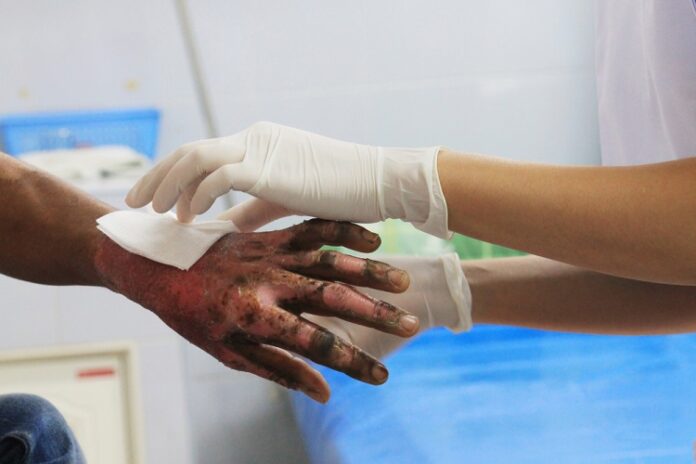Burn injuries can vary significantly in terms of severity, causes, and the resulting impact on a person’s health and well-being. Understanding the different types of burn injuries, their degrees, and the common causes behind them is essential for proper treatment and prevention.
In this article, we will explore the various categories of burn injuries and delve into their characteristics, causes, and potential treatments.
Table of Contents
First-Degree Burns
First-degree burns are the mildest form of burn injuries. They typically affect the outermost layer of the skin, known as the epidermis. Common causes of first-degree burns include brief exposure to hot liquids, steam, or minor sunburn.
First-degree burns present with redness, discomfort, and mild swelling. Most of the time, these burns recover in a few days without leaving any scars. Aloe vera gel or moisturizer application can help the healing process along with over-the-counter painkillers and cold compresses.
Second-Degree Burns
A second-degree burn is far more painful than a first-degree burn. There are two main categories of second-degree burns, including:
- Burns with a superficial partial thickness
- Partial-thickness burns that are deep
Superficial Partial-Thickness Burns
Both the epidermis and the dermis, the underlying layer, are affected by these burns. Blisters that hurt, redness, swelling, and a damp appearance are the results. Common causes include prolonged contact with hot items or being scalded by hot liquids.
Cleaning the burn, using antibiotic ointments, and using non-stick dressings to stop infection are all possible treatments. These burns may leave only minor scars and usually recover within a few weeks.
Deep Partial-Thickness Burns
These burns extend deeper into the dermis and cause similar symptoms as superficial partial-thickness burns but can be more severe. Blisters may be larger and filled with clear fluid or appear white.
Due to the deeper damage, healing can take several weeks, and there is a higher risk of scarring. In some cases, skin grafts might be necessary to aid in the healing process.
Third-Degree Burns
Burns of the third degree are the most serious and pierce all skin layers. These burns frequently result by coming into touch with chemicals, fires, or highly hot items for an extended period of time.
Nerve endings may be destroyed, giving little to no pain, and the affected area may seem burnt, bleached, or leathery. Third-degree burns need to be treated right away by a doctor since they can seriously harm tissue and result in complications. Surgery is used in the course of treatment to enhance healing and lessen scarring, such as skin grafts.
Fourth-Degree Burns
Fourth-degree burns affect deeper tissues, such as muscles, tendons, or bones, in addition to the skin. These burns are exceedingly severe and may result in death, permanent impairment, or both.
Emergency medical care is crucial for managing these burns, and extensive medical intervention, including surgeries, may be necessary to treat and manage the injuries.
Common Causes of Burn Injuries
According to a burn injury attorney in Philadelphia, Burn injuries can stem from a wide array of situations such as car, truck, and motorcycle accidents, often resulting from various factors and environments. Understanding the common causes of burn injuries is pivotal in preventing them and promoting safety. Here are some of the prevalent causes of burn injuries:
Thermal Burns
Flames and Fire: Residential fires, wildfires, or accidents involving flammable materials can lead to severe burns. Cooking-related incidents, such as grease fires, also fall into this category.
Hot Liquids and Steam: Spills of hot liquids, such as boiling water, coffee, or cooking oil, can cause scalding burns. Steam from boiling water or steam-related equipment can also lead to burns.
Chemical Burns
Household Chemicals: Exposure to corrosive substances found in common household products like bleach, drain cleaners, or strong acids can result in chemical burns.
Industrial Chemicals: Accidents involving chemicals in workplaces or industrial settings can cause burns, especially if proper safety measures are not in place.
Electrical Burns
Faulty Wiring: Electrical burns can occur if individuals come into contact with exposed or faulty wiring at home, in workplaces, or in public spaces.
Electrical Accidents: Accidental contact with live electrical currents, often seen in cases of electrical malfunctions or accidents involving power lines, can lead to severe burns.
Radiation Burns
Sunburn: Prolonged exposure to ultraviolet (UV) radiation from the sun can result in sunburns, particularly during hot and sunny weather.
Tanning Beds: Overuse of tanning beds, which emit concentrated UV radiation, can lead to burns and increase the risk of skin cancer.
Friction Burns
Road Rash: Motorcycle or bicycle accidents where the skin comes into contact with the road surface can cause friction burns, often referred to as road rash.
Sports Injuries: Athletes participating in contact sports or those involving high-speed movement can experience friction burns, especially when wearing inadequate protective gear.
Scalding Burns
Hot Bathwater: Hot bathwater or shower water can cause scalding burns, particularly in children or the elderly who may have difficulty regulating water temperature.
Kitchen Incidents: Accidents involving hot pots, pans, or cooking utensils can lead to burns if proper precautions are not taken.
Flammable Clothing: Clothing made from flammable materials can catch fire easily, resulting in severe burns. Loose-fitting clothing near open flames or heat sources poses a higher risk.
Fireworks: Mishandling or improper use of fireworks, particularly during celebrations, can lead to burn injuries due to explosions or direct contact.
Hot Objects: Accidental contact with hot surfaces, such as stovetops, irons, or heaters, can lead to burns.
Steam Accidents: Steam-related accidents, such as pressure cooker malfunctions or steam pipe leaks, can cause burns from exposure to high-temperature steam.
Practicing Caution When It Comes To Burn Injuries
Recognizing the diverse range of causes that can lead to burn injuries highlights the importance of practicing caution, adhering to safety guidelines, and being prepared to respond effectively in case of emergencies.
Preventive measures, such as using protective equipment, ensuring proper handling of chemicals, maintaining safe distances from heat sources, and practicing fire safety, play a crucial role in reducing the risk of burn injuries in various settings.




